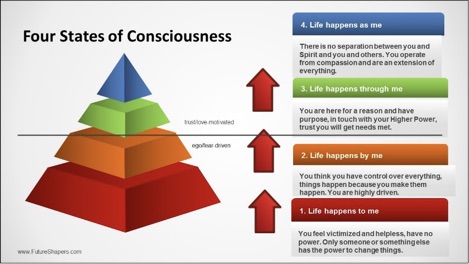The Four States of Consciousness and Human Adulthood
When we designed our FutureShapers model for the four states of consciousness (see graphic below) we were focusing on how our pyramid model compared to the four quadrant model developed by a group of colleagues over the years, most recently popularized by the authors of The 15 Commitments of Conscious Leadership.
It had not occurred to me until recently that there was a coinciding similarity to the adult versus adolescent human that I wrote about in my 2012 book – The Great Growing Up: Being Responsible for Humanity’s Future.
To recap our model’s description click here for the original article. Here is our model described graphically:

Note the horizontal black line that separates the bottom two states from the top two. The two states of consciousness below the line are described as fear- and negative ego-based while the two states above the line are trust-based. You could also label the upper states as integrated (or whole) and the lower as segregated (or fragmented).
The state of consciousness represented at the top of the pyramid (in blue) can be descibed as that nondual state of oneness where “life happens as me.”
Recently, I realized how this model overlaps my idea of human adulthood. In Growing Up, I pointed out that a majority of human beings are still adolescents when it comes to emotional maturity. Some may be high-functioning adolescents but they are adolescents nonetheless.
The lower two states oof consciousness are where adolescents hang out (below the line) while adult humans reside above the line. As we mentioned in the “Four States” article, we will travel from state to state as life throws us curve balls from time to time but we’ll usually spend most of our time living in one state, even though we may “vacation” in other states. The victim (the lowest state of consciousness in these models) may have higher state experiences and those normally residing in the higher states may have setbacks that occasionally take them to the fearful and mistruting lower states.
Nondualist author Jed McKenna writes extensively about Human Adulthood. He writes, “Most people stop growing at around the age of 10 or 12 and die in the nest they were born in. It would be easy to believe that many, if not most, of the woes of mankind, on both the individual and societal levels, stem from this state of arrested development.”
I’ll focus on McKenna’s writings on Human Adulthood in a future blog on the Growing Up website.
